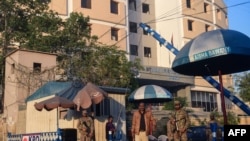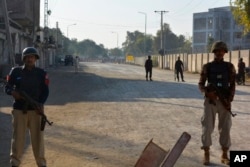Russian Foreign Ministry spokeswoman Maria Zakharova was recently asked about media reports that the Pakistani Taliban are fighting government forces with U.S.- manufactured arms.
Zakharova spun those reports into a conspiracy theory, claiming the West "wants to use the resources of terrorist groups in the region to further degrade the state of affairs in its selfish interests.”
“It seems like the Americans deliberately left these weapons there [in Afghanistan], and now they are destabilizing the situation because terrorists may get hold of them,” she said. “We will not be surprised if these weapons soon surface in disputed areas of the region and other places.”
That is false.
The U.S. withdrawal of troops from Afghanistan in August 2021 has been closely scrutinized both at home and abroad. But the United States did not intentionally leave weapons behind for the sake of arming the same forces it battled for two decades. Nor is it seeking to support Taliban militants in Pakistan.
Counterterrorism was the primary goal of U.S. operations in Afghanistan, although the U.S. later “drifted” into nation-building.
The United States spent hundreds of billions of dollars in prosecuting the Afghanistan war and efforts to rebuild the country. It also spent nearly $90 billion in security sector assistance to turn the Afghan National Defense and Security Forces into “an independent, self-sustaining force capable of combating both internal and external threats,” according to the Special Inspector General for Afghanistan Reconstruction (SIGAR), a watchdog agency created by the U.S. Congress.
“At various points, the U.S. government hoped to eliminate al-Qaeda, decimate the Taliban movement that hosted it, deny all terrorist groups a safe haven in Afghanistan, build Afghan security forces so they could deny terrorists a safe haven in the future, and help the civilian government become legitimate and capable enough to win the trust of Afghans,” SIGAR said.
The United States failed to achieve those goals by the time its military forces withdrew from Afghanistan.
When the U.S. forces left Afghanistan in August 2021 — a process described as “rushed and chaotic” by the International Center for Counter-Terrorism, a Hague-based think tank — Afghan security forces collapsed. This allowed the Taliban to seize “large quantities of small arms and light weapons,” including assault rifles, pistols and machine guns, along with heavy weapons and equipment.
Following the takeover of Afghanistan, a spokesman for the Taliban told Al Jazeera, that the group had taken control of 300,000 light arms, 26,000 heavy weapons and 61,000 military vehicles.
The U.S. Department of Defense estimated in August 2022 “that U.S.-funded equipment valued at $7.12 billion was in the inventory of the former Afghan government when it collapsed, much of which has since been seized by the Taliban. This included military aircraft, ground vehicles, weapons and other military equipment.”
Losing billions in arms to the Taliban strengthened the very forces the U.S. had sought to counter in the region. The acquisition of those weapons not only served to strengthen the Taliban’s hand, but also served as a propaganda victory against the United States.
“The surplus of weapons will last for decades, prolong insecurity for the Afghan people and provide further opportunities for the Taliban to consolidate their control over territory, generate increased funding through arms trafficking and other criminal activities, and amplify their success through propaganda,” read an International Center for Counter-Terrorism policy brief.
The arms, through various means, have also changed hands.
Radio Free Europe/Radio Liberty (RFE/RL), a VOA sister organization, reported some of those U.S. arms had “turned up in neighboring Pakistan, where they have been used by armed groups,” including the Tehrik-e Taliban Pakistan (TTP) militant group. Described by researchers at Stanford University as “the largest and deadliest militant umbrella organization in Pakistan,” the TTP declared war on Pakistan’s government in 2007.
The TTP sought to establish a “unified front” to combat U.S.-led coalition forces in Afghanistan. It is waging war against Pakistani security forces and seeks to enforce Shariah law in the region.
The TTP is organizationally separate from its Afghan counterpart but “inspired” by it. The group also has links to al-Qaida.
Pakistani military commanders have called the Afghan Taliban and the TTP “two faces of the same coin.”
Yet Pakistan was a major source of support to the Afghan Taliban during its insurgency against U.S. forces. Some analysts warned Islamabad that it would come to regret that support.
“The ideological connection that has helped Pakistan control the Taliban in Afghanistan has also paved the way for growing Islamist radicalization in Pakistan itself,” Vinay Kaura, a nonresident scholar at the Washington, D.C.-based Middle East Institute argues.
The Afghan Taliban has sheltered TTP fighters and released those captured by the previous Afghan government. According to analysts at the United States Institute for Peace, an American federal institution funded by the U.S. Congress, the Afghan Taliban exhibited its “determination to continue supporting the TTP,” including providing the group safe haven on Afghan soil, despite “intensified pressure from Pakistan.”
Still, the Afghan Taliban denies it is supplying U.S.-made arms to the TTP.
But civilians and Taliban fighters have reportedly sold their weapons on the black market.
The Taliban has downplayed the risks of more arms being smuggled across the porous border region between Afghanistan and Pakistan.
"If some weapons are being smuggled, they are far fewer and not of much concern," Zabihullah Mujahid, an Afghan Taliban spokesman, told RFE/RL's Radio Azadi.
Contrary to Zakharova’s claim that the U.S. wants to destabilize the region, Asfandyar Mir, a senior expert on South Asia at the United States Institute for Peace, said in February that the TTP can threaten U.S. interests “by seriously destabilizing Pakistan” and thereby “raise the specter of eroded Pakistani nuclear security, broader regional instability and migration concerns.”






